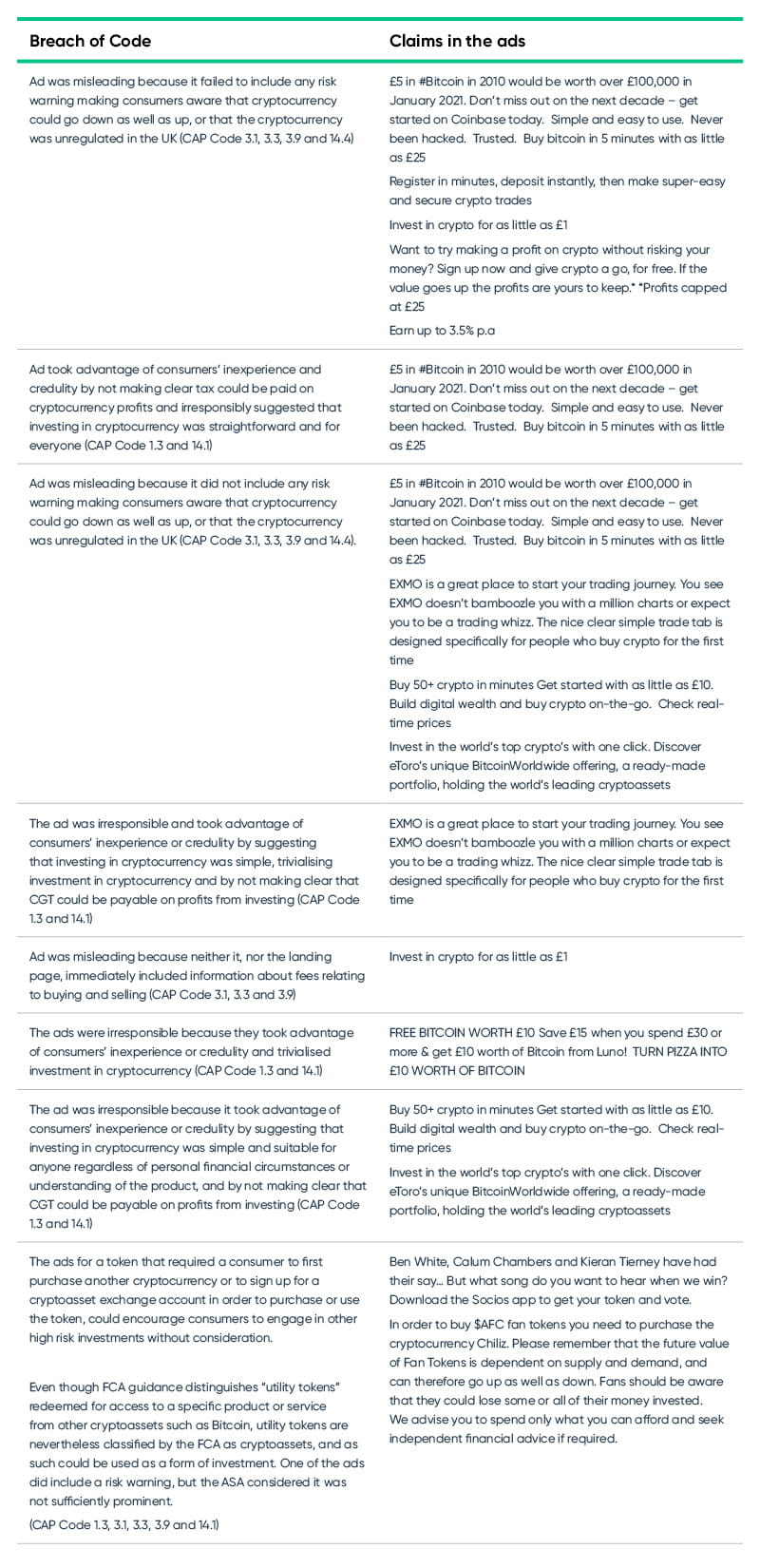The ASA announced in November 2021 that advertising of cryptoassets, cryptocurrencies and NFTs was a 'red alert priority issue' for them. They followed through on that notice and, in December 2021 and January 2022, published ten rulings about crypto ads, all of which found the advertising to breach the CAP Code.
When we've been advising on cryptoassets and NFTs, a key issue has been how accurately to communicate the risks, rights and benefits attaching to the assets. The ASA has now made it clear that advertisers need to tread very carefully, including by giving sufficient warnings to consumers.
Background
CAP had, in April 2021, already called out the risks of advertising cryptocurrency and NFTs. They include:
- the need to make clear that the value of investments is variable and can go down as well as up. Advertising the benefits of the cryptocurrencies needs to communicate the risks too. Given their volatility, a small print disclaimer might not be enough to comply
- the complexity of cryptos and NFTs means that advertisers may need to choose language which would be readily understood by its audience, and that will depend in part on choice of media
- their novelty means that advertisers need to be careful not to take advantage of consumers' inexperience or credulity. That means that, when identifying the average consumer from whose perspective the ASA will judge compliance with the Codes, advertisers may need to set a low bar for how reasonably well-informed, observant and circumspect the average consumer is. We have seen in other contexts the ASA justify its reasoning by taking a 'lowest common denominator' approach on the average consumer and this appears to be the approach they will be taking here as well.
Specifically on NFTs, CAP also called out the obvious but easily overlooked points that the NFT is not the piece of art or image itself, sale of an NFT for a digital file doesn't stop the seller sending another copy of the file to someone else, and owning an NFT doesn't mean that you own the copyright. This all makes it important not to overstate what buying an NFT actually provides the buyer with and to explain what it entitles them (and others) to do with the file. We covered these and other issues in our earlier article "NFTs – a question of ownership".
The ASA's November 2021 announcement then identified its concerns about:
- lack of appropriate risk warnings
- the trivialisation of investments in cryptocurrency
- ads taking advantage of consumers’ inexperience or incredulity
- irresponsible advertising (for example, creating a sense of urgency to invest).
It warned that it will carry out proactive monitoring and enforcement to tackle non-compliant ads for cryptoassets.
Financial services regulation of cryptoassets: change in the pipeline
Currently, cryptocurrencies such as Bitcoin are not regulated in the UK. Only certain types of cryptoassets, so-called 'security tokens' and 'e-money tokens', require firms to be authorised by the FCA, with other types of cryptoasset activity requiring registration under money-laundering legislation.) What is regulated, and what is not, is complex. CAP cautioned that marketers shouldn't imply that cryptocurrencies are regulated, and highlighted the CAP rules that ads must make clear that the value of investments is variable and can go up as well as down.
The FCA currently has no enforcement against ads relating to cryptocurrencies by unregulated businesses. However this looks set to change. On 18 January 2022, the UK government announced its intention to regulate the promotion of certain "qualifying cryptoassets" in the UK (see our separate briefing, here).
The extension of the financial promotion regime will mean that any communications that are "invitations or inducements" to engage in certain activities relating to "qualifying cryptoassets" will be prohibited unless an exemption applies, the content of the communication is approved by an authorised firm, or the person making the communication is itself authorised. The restriction will apply to any in-scope promotion capable of having an effect in the UK, even if communicated by an overseas person. Communicating a promotion in breach of the restriction will be a criminal offence.
The proposed legislative change means that in future, businesses that are not FCA-authorised will need to ensure that any promotion of "qualifying cryptoassets" either falls within an exemption, or otherwise arrange for the content of the communication to be approved.
However these changes are yet to be adopted (and once adopted will likely involve a transition period of "approximately six months"). In the meantime, in the absence of FCA enforcement powers, the ASA is taking action on cryptoasset ads instead.
Outcomes from the rulings
We set out below a summary of ads which were found to breach the CAP Code and why. The majority of cases related to crypto exchanges or trading platforms and the ASA was the complainant in each, reflecting the importance it is placing on compliance.

Lessons from the rulings
Gathering these rulings together allows us to take some key lessons from them.
Assume that the knowledge of the general public is low
The ASA is likely to consider that the general public will probably be inexperienced in their understanding of, and not have any specialist knowledge of investing in, cryptocurrency. That means advertisers have to acknowledge the complexity of cryptoassets, that gains are susceptible to tax and that the asset class is not for everyone, and they need to avoid simplifying or trivialising them and rushing consumers into investing.
Do not imply (including by omission) that crypto is simple or trivialise it
According to the ASA, cryptocurrency investment is sophisticated and complex, subject to frequent change in value and could potentially lead to large losses. As a result, ads that highlight eg the ease of making trades, or of using a platform or app, but which don't contain warnings or other information, will likely be taken by the ASA to mean that crypto investments are straightforward, effortless and suitable for anyone regardless of their personal circumstances and understanding of what they were investing in. It is likely to be irresponsible to suggest that investing in cryptocurrency is straightforward and for everyone regardless of their personal circumstances and understanding of what they were investing in.
Use of a cashback promotion could take advantage of consumers' inexperience or credulity. A cashback promotion to encourage investment in cryptocurrency could trivialise and distract from a serious and potentially costly financial decision.
Focusing an ad on the low cost of investing could lead consumers to understand that cryptocurrency was straightforward and accessible at low cost to all users regardless of their understanding of the product or personal circumstances.Doing so could take advantage of consumers' inexperience or credulity and should be avoided.
Attaching a cryptocurrency promotion to another product (eg buy X and get free Bitcoin) could encourage consumers to engage in such a high risk investment without consideration and trivialise a serious and potentially costly financial decision. That should also be avoided.
Make it clear that cryptoassets can go up and down in value and that cryptocurrencies are unregulated in the UK
The ASA is likely to consider it material for consumers to be aware that a cryptoasset may be unregulated, that they can go down as well as up, and don't give consumers the right to seek recourse under the Financial Services Compensation Scheme or the Financial Ombudsman Service. This therefore likely needs to be made clear in the ad, alongside any other significant limitations and qualifications. On a Twitter bio, for example, even though it's limited to 160 characters, it's possible to include a qualification in the image at the top of the page. Putting the relevant information in the footer of a website, where it is not immediately visible and consumers would have to scroll a long way to locate it, is not clear enough.
The ASA's view is that cryptocurrency is a volatile, unregulated investment, subject to frequent change and one that could potentially lead to large losses. That is material information which needs to be clearly and prominently communicated in a risk warning.
Tax
Ads may need to refer to capital gains tax being payable on cryptocurrency profits once annual tax free allowances are exhausted; the ASA considers that the general public would be unlikely to be aware of the potential need to pay CGT on cryptocurrency gains. Not making the potential tax implications sufficiently clear could take advantage of consumers' inexperience and credulity
Don't use the past to mislead about the future
Ads should make clear that past performance or experience does not necessarily give a guide for the future. So, for example, using the past performance of Bitcoin to encourage consumers to use a service, without making it clear that the example was not necessarily a guide for the future, could mislead.
Communicate buying and selling fees
Buying and selling fees are likely to be material information to consumers, especially in the context of ads that focus on purchasing cryptocurrency and doing so at a low price. Fees therefore need to be clearly communicated in ads. If space doesn't allow (eg in a Tweet) then the advertiser would need to make the information available using other means eg clearly and prominently on a landing page from the Tweet. Communicating that information later on in the purchase journey would be too late.
Give risk warnings sufficient screen time and prominence
As the above discussion demonstrates, a considerable amount of information needs to be communicated to consumers to avoid breaching the Code. When presented with that information, consumers need to have sufficient time to understand disclaimers in full and to apply it to the specific information provided in an ad about the product. For example, running a risk warning for one second at the beginning of a 20-second ad would mean that the information would not be fully read or understood even if it was seen at all. Risk warnings at the bottom of an ad might not be sufficiently prominent as consumers might engage without seeing the warning.
Ongoing scrutiny
Regulators around the world are grappling with how to regulate different types of cryptoassets, in particular risks to consumers. The ASA's decisions show that although certain cryptocurrencies and NFTs are not yet within the FCA's remit, other regulatory and consumer law considerations are still relevant.
Cryptoasset businesses should be aware of the potential for ASA enforcement action, and the reputational consequences which follow from it, as well as the possibility for the ASA to share information with the FCA. Accordingly, they should be prepared to justify how their ads are defensible in light of these recent decisions.












